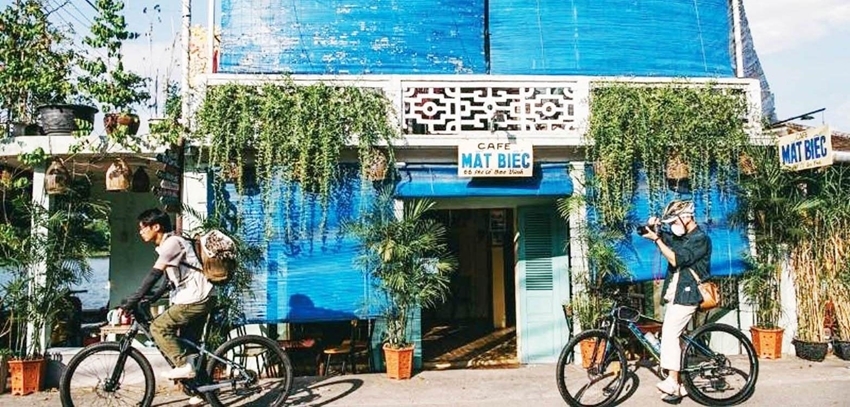 |
| Mat Biec café |
Bao Vinh Old Quarter increasingly attracts visitors
Bao Vinh Old Quarter (in Huong Vinh Ward, Hue City) is located in the north of the outer citadel. It is considered the largest trading port of the Cochinchina for two centuries, between the seventeenth and nineteenth centuries. There were many traders from China, Japan, India and even Europe coming here to exchange and trade goods.
Today, Bao Vinh Old Quarter is only about 3 kilometers from the city center of Hue. It is easy for tourists to come and see the ancient features of the neighborhood of a few hundred years of age.
The places in Bao Vinh Old Quarter on the bucket list include the communal house of Bao Vinh village, the Bao Vinh wharf, the Bao Vinh market, and Thien Giang pagoda. Another unique feature in Bao Vinh Old Quarter is the architecture of two-story pillared houses, which is rare in Hue.
Located in the downstream area of the Huong River, the Edufarm of Bao Vinh Old Quarter (in Trieu Son Nam Residential Group, Huong Vinh Ward, Hue City) has attracted a large number of visitors. They can experience activities such as horseback riding, boating, fishing, camping, as well as playing with pets in this 8,000-square-meter farm.
Tiktoker Nguyen Phuoc Dat, who specializes in Hue cuisine, is excited to share with viewers dishes for breakfast at Bao Vinh market in the Old Quarter. Starting with chao long, then banh beo, banh nam, banh loc, bun hen, bun rieu, and jelly, all are at affordable prices. Nguyen Phuoc Dat’s impression is that the merchants here are friendly and hospitable, and the food is delicious.
Besides, Bao Vinh market is the one that retains the ancient features bearing the architectural essence of a pillared house; so, visitors to the market can feel the spirit of the ancient Hue merchants.
Gia Hoi Old Quarter still has a lot of room for tourism
There is now a website called phocogiahoi.vn to promote Gia Hoi Old Quarter (in Gia Hoi ward, Hue city). Visiting this website, visitors will experience the “virtual tour” around Gia Hoi Old Quarter. Besides, visitors will also find on this website useful information about the old quarter such as where to visit and stay, what to eat, and which tour to book.
In early September 2018, there was a tour called “Wheeling with Hue” co-organized by the Provincial Department of Tourism and Beebee Travel. On a cyclo, visitors can discover and listen to many anecdotes about Chi Lang, Gia Hoi, visit Dieu De Pagoda, the Assembly Hall of Phuc Kien - Trieu Chau, and stop to buy some sesame candy at Thien Huong, a specialty brand that brought Hue to the world.
Pursuant to Resolution No. 1264/NQ-UBTVQH14 dated April 27, 2021 by the Standing Committee of the National Assembly, effective as of July 1, 2021, Gia Hoi Ward is established on the basis of merging two wards Phu Cat and Phu Hiep with their entire natural area and population. This is an advantage in the management and conservation of Gia Hoi Old Quarter.
In December, 2021, the Institute for Research and Development of Thua Thien Hue province held a conference on “Solutions to developing the Gia Hoi Old Quarter into a typical commercial street of Hue city”. It aims to affirm the values of history, culture and architecture of Gia Hoi Old Quarter and to serve as a scientific foundation for orienting research and implementing appropriate solutions in the future.
In addition, the conference also evaluated the current status of Gia Hoi Old Quarter in terms of planning management, construction and architectural landscape. According to a survey conducted by Thua Thien Hue Development Research Institute (in September, 2021), there are 83 tangible heritages in Gia Hoi Old Quarter, three of which have been classified as National Monuments, namely, the Temple of The Lai Thuong, the worship hall of goldsmithing, and Thanh Binh ancestry worship hall.
Situated in the southeast of the outer citadel, Gia Hoi Old Quarter is a land imbued with Hue culture. Gia Hoi Old Quarter is located on an island surrounded by the Huong River and the Dong Ba River.
This old quarter was formed after the Nguyen Lords moved the capital of Cochinchina from Hoa Chau citadel to Kim Long (in 1636) and Phu Xuan (in 1687). When the Nguyen Dynasty was established in 1802, Gia Hoi Old Quarter, located next to Hue Citadel, developed rapidly and became a busy town. It can be affirmed that Gia Hoi Old Quarter can be seen as the most vivid and true evidence of the ancient Hue people’s life. The most special in Gia Hoi Old Quarter is a series of mansions of the royal family members, and high-ranking officials of the royal court.
Gia Hoi Old Quarter is home to a rich culinary life with famous specialties of Hue. Thien Huong sesame company in Chi Lang Street, Old lady Keo’s beef noodle restaurant in Bach Dang Street, and Ms. Do’s banh beo, nam and loc in Nguyen Binh Khiem Street have been famous for a long time and attracted a large number of diners. In addition to these specialties, there are also many other delicious dishes.